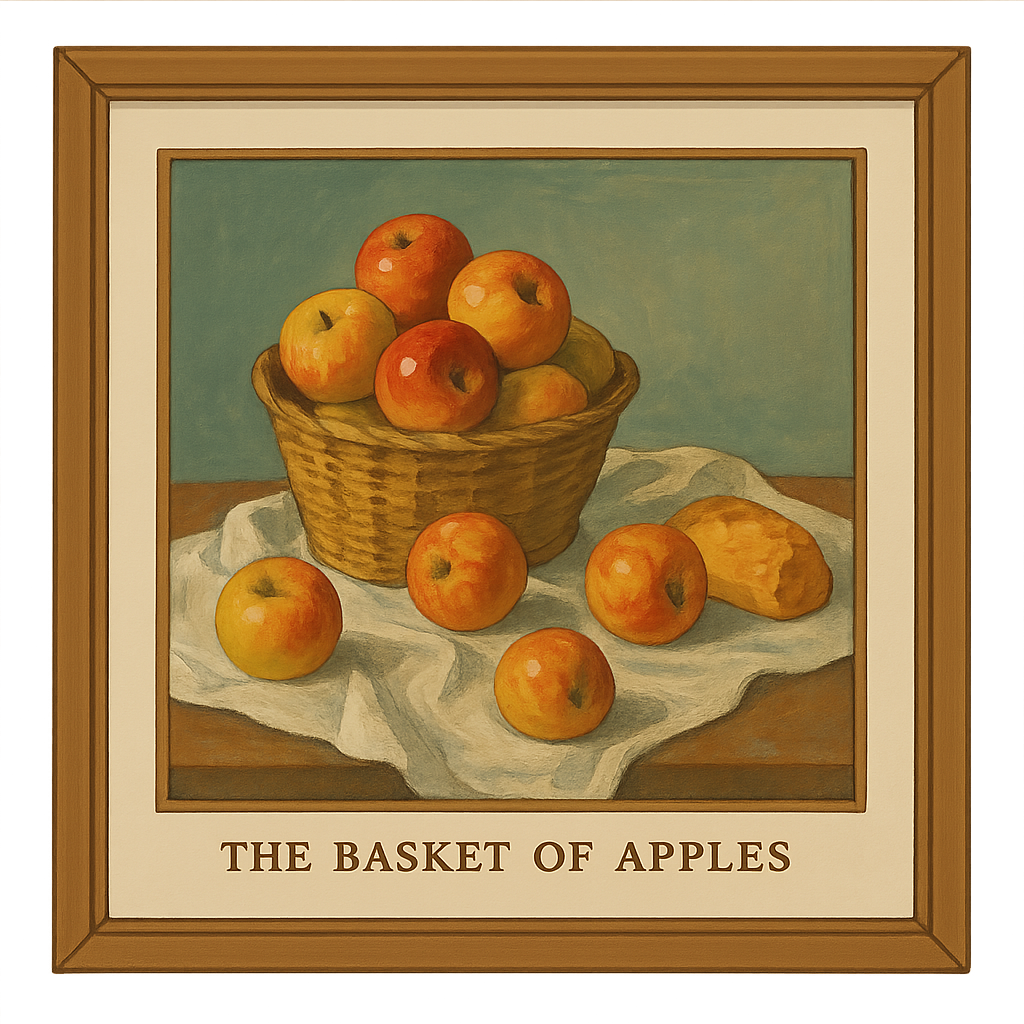The Basket of Apples
Look closely at me. Can you see the round, rosy apples spilling out of my wicker basket? They seem to have a mind of their own, tumbling over each other in a cheerful pile. Some are fire-engine red, some are sunny yellow, and they all look so deliciously lumpy, as if they might roll right off the table and into your hands at any second. To their right stands a tall, dark bottle of wine, leaning just a little bit, like a shy giant listening to a secret. And the tablecloth. oh, the magnificent tablecloth. It isn’t flat and boring like you might expect. My creator made it all rumpled and folded, a landscape of soft, white hills and valleys. There are even some crunchy-looking biscuits peeking out from behind a fold, just waiting to be nibbled. Nothing in my world is perfectly straight or mathematically correct. The table seems to tilt forward, the bottle leans, and the basket sits at a funny angle. It’s a bit wobbly, a bit wonky, and that’s what makes it so wonderfully alive. That’s the secret to my charm, you see. I am not just a picture of some fruit and a bottle on a table. I am a painting, and my name is The Basket of Apples.
The man who brought me to life was a painter named Paul Cézanne. He was a quiet, incredibly patient man with a magnificent beard, and he worked on me around the year 1893 in his sunny studio in France. Paul wasn't interested in making me look like a photograph. He thought that was a bit boring. A camera can show you exactly what something looks like in a single blink, but Paul wanted to show you what it felt like to truly see something over time. He believed that looking was an adventure, not just a quick glance. For hours, even days, he would sit and stare at the apples, the bottle, and the cloth. He was like a detective searching for clues. He would move his head slightly to the left, then to the right. He’d lean in close to see the shine on an apple, then stand back up to see how the whole scene fit together. He was trying to capture all those different views and feelings at the very same time. Can you imagine trying to draw a cup from the top, the side, and from a little bit below, all in the same picture? That’s the magic he worked on me. Here's my big secret: the left side of the table doesn't match the right side. The edge on the left is higher than the edge on the right because he was painting what he saw from two different spots. It makes me look a little wobbly, but it also makes me feel solid and real, like you could reach out and touch the cool glass of the bottle. He wasn't making a mistake; he was making a discovery. He discovered that a painting could hold more than one moment in time, showing you an object from all around. I am not just a still life; I am an experience, an idea about how our eyes and brains work together to understand the world.
When I was first shown to the world, not everyone understood me. 'The table is crooked.' they would say. 'The bottle is falling over.' Some people thought my painter, Paul, had just made a lot of clumsy mistakes. They were used to paintings that looked perfectly smooth and realistic, like a window into another room. I must admit, it was a bit confusing for them. But then, other artists saw me, and a spark of excitement lit up in their eyes. They didn't see mistakes; they saw a brilliant new idea. They understood that Paul was breaking the old rules to show them a new way to paint, a way that was more honest about how we actually see. My wobbly perspective and solid shapes inspired a whole new kind of art called Cubism. A very famous artist named Pablo Picasso looked at works like me and thought, 'What if I showed a face from the front and the side at the same time?' My little basket of apples helped change art forever. Today, I don't live in a small studio anymore. My home is a very grand museum called the Art Institute of Chicago. People from all over the world come to visit me, standing in front of my frame, tilting their heads just like Paul used to do, trying to unravel my wonderful, wobbly secrets.
So, the next time you sit down for a snack, take a moment to really look. Don't just see an apple; see the roundness, the way the light makes a little star on its shiny skin, the tiny brown stem. Notice how the glass of water bends the light, or how the folds in a napkin create shadows. Paul Cézanne saw the whole world in a simple basket of fruit, and he showed everyone that there is magic in paying attention. I am here to remind you of that. Art isn't just about drawing things perfectly so they look exactly like a photograph. It’s about sharing your special way of seeing the world with others. Looking closely and using your imagination can make even the most ordinary things, like a few apples on a table, feel completely extraordinary.
Reading Comprehension Questions
Click to see answer
